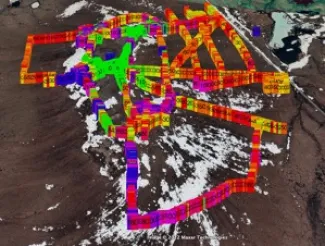A multi-institutional team from the NGEE Arctic project completed its end-of-winter snow survey campaign. The Teller data collection included 3162 Magnaprobe snow depth and 63 density/snow water equivalent (SWE) measurements. The Kougarok hillslope data collection totaled 3978 Magnaprobe snow depth and 48 density/SWE corer measurements. The weather was colder than previous years, which was good for the campaign (temperatures dropping to -1 °F / -18 °C and 17.3 mph winds) but led to some minor challenges in staying warm in the field, which were all overcome by an abundance of warm weather gear, hand and toe warmers (in boots and attached to iPhones!), and of course, high quality, sugary sweets and treats. The survey included detailed capture of snow depth points over the top of our instrumented iButton and sub-surface temperature probes nests, which were instrumented in September 2021 and have been capturing snow and soil temperatures throughout the winter. We are currently in the process of updating the data sets for publication into the data portal and updating our statistical snow distribution models with this new information. An exciting and interesting development of the 2022 end-of-winter campaign was that we captured a rain-on-snow affected snow scenario, as several rain events occurred over the 2021-2022 wintertime. This rain-on-snow affected snow, at first glance, may have different characteristics, as snow layers were shallower, but the same density as some of our higher snow years (i.e., 2019) and the 2022 data falls within the variability of the other four survey years. The team will be considering this new data point as we incorporate the snow year into our statistical and physical snow distribution simulations.
For more information, please contact:


